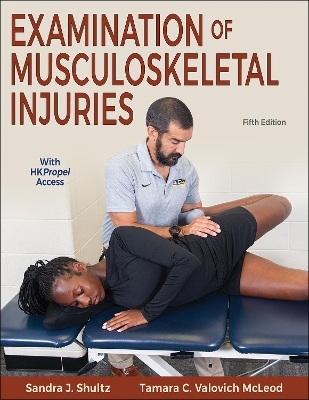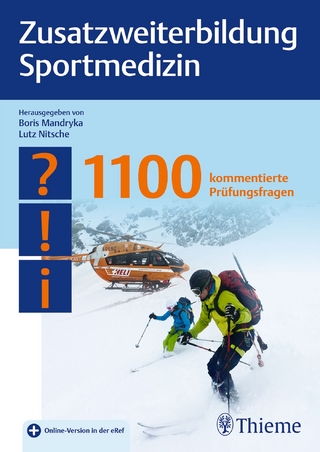
Examination of Musculoskeletal Injuries
Human Kinetics (Verlag)
978-1-7182-2831-3 (ISBN)
- Noch nicht erschienen (ca. April 2025)
- Versandkostenfrei innerhalb Deutschlands
- Auch auf Rechnung
- Verfügbarkeit in der Filiale vor Ort prüfen
- Artikel merken
Examination of Musculoskeletal Injuries, Fifth Edition With HKPropel Access, guides athletic trainers and health care professionals through the examination and diagnosis of musculoskeletal injuries, both on and off the field. Integrating updates from the fifth edition of the Athletic Training Educational Competencies, the text addresses several areas of clinical practice that students must master to pass the Board of Certification (BOC) examination. The text also includes a significantly expanded online video library that now contains more than 240 video clips that clearly demonstrate evaluation techniques so that students can see firsthand how to perform each assessment.
From introductory skills for injury examination to specific techniques to be used for examining each region of the body, Examination of Musculoskeletal Injuries will teach students to obtain an accurate injury history from the patient, inspect the injury and related areas, palpate both bone and soft tissues, assess motion control and function, and examine neurological and cardiorespiratory status. The text includes special tests that are used to assess different structures and to rule out or diagnose injuries for that region. Strategies are offered for examinations that occur immediately after an injury as well as those that are seen later in a clinical setting. Full-color photos and medical artwork clarify testing techniques and enhance knowledge of body structures. Updates in this fifth edition include the following:
An extensive video library with more than 190 new videos, for a total of 243 videos showcasing range of motion, muscle testing, and special test techniques
The addition of 35 new special tests and injury-specific examinations: instructions; photos and videos demonstrating how to perform them; and sensitivity, specificity, and likelihood ratios to help drive a clinician’s choice in test and support the clinician’s diagnosis
A new exploration of the latest concussion examination techniques, including the Sport Concussion Assessment Tool (SCAT), with a video that allows readers to observe and practice the SCAT
A section on patient-reported outcome measures (PROMs) for each body region; a quick reference table features the most recommended PROMs and information on what they help assess
In addition to video, other related online tools that support student learning are delivered through HKPropel. Checklists, tables, and forms assist in the examination of range of motion, strength, and neurological function. New case studies help students understand the clinical application of examination techniques. Lab activities and key term flash cards help students engage with the content. Key concepts, review questions, and critical thinking questions foster better understanding and retention, while chapter quizzes can be assigned by instructors to assess student comprehension.
Examination of Musculoskeletal Injuries, Fifth Edition, is an essential resource for examining and differentiating the pathologies encountered in musculoskeletal systems. It will prepare athletic training students for certification and guide any clinician or therapist in diagnosing musculoskeletal injuries.
Note: A code for accessing HKPropel is included with all new print books.
Sandra J. Shultz, PhD, ATC, FNAK, FNAP, is a professor and chair in the department of kinesiology at the University of North Carolina at Greensboro, where she serves as codirector of the Applied Neuromechanics Research Laboratory and as director of the Center for Women’s Health and Wellness. As a researcher, Shultz focuses on the study of risk factors for anterior cruciate ligament injury in female athletes and has received grant funding from the National Federation of State High School Associations (NFHS), the National Athletic Trainers’ Association (NATA) Research and Education Foundation, the National Football League Medical Charities, and the National Institutes of Health. She is the primary author of the NFHS’s Sports Medicine Handbook and the NATA’s Appropriate Medical Care for Intercollegiate Athletics. She has served as a senior associate editor for the Journal of Athletic Training and currently serves as an editorial board member for Sports Health. Shultz is a certified athletic trainer and member of NATA, where she has a long history of leadership and service. Shultz was inducted into the NATA Hall of Fame in 2015. Her awards from the NATA and NATA Foundation include the Dr. Freddie & Mrs. Hilda Pang Fu New Investigator Award, the Most Distinguished Athletic Trainer Award, the Sayers “Bud” Miller Distinguished Educator Award, and the Medal for Distinguished Athletic Training Research. Shultz is a fellow of the NATA, the American College of Sports Medicine (ACSM), and the National Academy of Kinesiology (NAK). Tamara C. Valovich McLeod, PhD, ATC, FNATA, FNAK, FNAP, is a professor and director of the athletic training department at A.T. Still University in Mesa, Arizona, where she serves as the John P. Wood, D.O., Endowed Chair for Sports Medicine. McLeod was the founding director of the Athletic Training Practice-Based Research Network at A.T. Still University. As a researcher, McLeod has focused on the pediatric athlete with respect to sport-related concussions. She serves as an associate editor of the Journal of Sport Rehabilitation and a senior editor of the Journal of Athletic Training. McLeod is a certified athletic trainer and fellow of the National Athletic Trainers’ Association (NATA), where she has a long history of leadership and service. She is a contributing author for the NATA position statements on the management of sport-related concussions and the lead author on the NATA position statement on the prevention of pediatric overuse injuries. In 2016 McLeod was honored by NATA with the Most Distinguished Athletic Trainer Award, and she received the Medal for Distinguished Athletic Training Research from the NATA Foundation in 2023. McLeod is heavily involved in professional service with the Arizona Interscholastic Association; the NFL Head, Neck, and Spine Committee; and the Brain Injury Association of Arizona. In 2019, she received the National Achievement Award for Athletic Training from the Pediatric Research in Sports Medicine (PRiSM) Society.
Part I. Principles of Examination
Chapter 1. Anatomical Nomenclature and Injury Classifications
Anatomical Reference Terminology
Physical Maturity Classifications
Injury Classifications
Closed (Unexposed) Wounds
Open (Exposed) Wounds
Summary
Chapter 2. Principles of Examination: An Overview
Proper Use of Terminology
Examination Components
Documenting the Examination
Summary
Chapter 3. Taking a History
General Principles
Situation-Specific History and Depth of Inquiry
Summary
Chapter 4. Observation
General Principles
Details of Specific Observation
Summary
Chapter 5. Palpation
General Principles
Structures to Palpate
Palpation Strategies
Summary
Chapter 6. Active and Passive Joint Motion
General Principles
Prerequisites for Successful ROM Examination
Examination of Physiologic Range of Motion
Examination of Accessory Motion
Examination of Ligament and Capsule Integrity
Summary
Chapter 7. Muscle Testing
General Principles
Manual Muscle Testing
Instrumented Muscle Testing
Summary
Chapter 8. Neurological Status
General Principles
Region-Specific Neurological Examination
Summary
Chapter 9. Cardiorespiratory Status
General Principles
Examination of Cardiorespiratory Status
Shock (Cardiovascular Collapse)
Summary
Chapter 10. Putting It All Together: General Examination Strategies
On-Site Examination
Acute Examination
Clinical Examination
Summary
Part II. Region-Specific Examination Strategies
Chapter 11. Cervical and Upper Thoracic Spine
Functional Anatomy
Regional Examination
Injury Recognition and Special Tests
Injury Examination Strategies
Summary
Chapter 12. Shoulder and Arm
Functional Anatomy
Regional Examination
Injury Recognition and Special Tests
Injury Examination Strategies
Summary
Chapter 13. Elbow and Forearm
Functional Anatomy
Regional Examination
Injury Recognition and Special Tests
Injury Examination Strategies
Summary
Chapter 14. Wrist and Hand
Functional Anatomy
Regional Examination
Injury Recognition and Special Tests
Injury Examination Strategies
Summary
Chapter 15. Lower Thoracic and Lumbar Spine
Functional Anatomy
Regional Examination
Injury Recognition and Special Tests
Injury Examination Strategies
Summary
Chapter 16. Leg, Ankle, and Foot
Functional Anatomy
Regional Examination
Injury Recognition and Special Tests
Injury Examination Strategies
Summary
Chapter 17. Knee and Thigh
Functional Anatomy
Regional Examination
Injury Recognition and Special Tests
Injury Examination Strategies
Summary
Chapter 18. Hip, Pelvis, and Groin
Functional Anatomy
Regional Examination
Injury Recognition and Special Tests
Injury Examination Strategies
Summary
Chapter 19. Head and Face
Functional Anatomy
Regional Examination
Injury Recognition and Special Tests
Injury Examination Strategies
Summary
Chapter 20. Thorax and Abdomen
Functional Anatomy
Regional Examination
Injury Recognition and Special Tests
Injury Examination Strategies
Summary
| Erscheint lt. Verlag | 18.4.2025 |
|---|---|
| Verlagsort | Champaign, IL |
| Sprache | englisch |
| Themenwelt | Medizin / Pharmazie ► Medizinische Fachgebiete ► Sportmedizin |
| Medizin / Pharmazie ► Physiotherapie / Ergotherapie ► Rehabilitation | |
| ISBN-10 | 1-7182-2831-7 / 1718228317 |
| ISBN-13 | 978-1-7182-2831-3 / 9781718228313 |
| Zustand | Neuware |
| Informationen gemäß Produktsicherheitsverordnung (GPSR) | |
| Haben Sie eine Frage zum Produkt? |
aus dem Bereich


